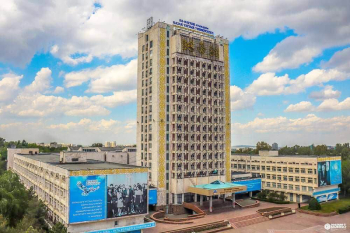Al-Farabi Library organized a book exhibition on the occasion of the International Day against Nuclear Tests.
The history of nuclear testing is a history of suffering. The victims of more than 2,000 nuclear tests were often among the most vulnerable groups in the population. The devastating effects of nuclear disease on individual borders and covering the impact on the environment, health, food security and economic development.
On December 2, 2009, the sixtieth fourth session is a clear definition of the causes of occurrence, by unanimously adopting Resolution 64/35, which declared the 29th August International Day for Action against Nuclear Tests. A development resolution to more actively educate people “about the consequences of nuclear weapons test explosions and any other nuclear explosions and the need for their development as one of the means to achieve the goal of building a world free of weapons from American weapons.” With the initiative of accepting this meeting, an open large number of authors and co-authors, the Republic of Kazakhstan came forward in order to mark the closure on August 29, 1991 of the Semipalatinsk association of the test site.
Exhibition date: 29 August in 2022
The exhibition consists of 3 parts:
- Hirosima men Nagasakige atom bombalarynyn tastaluy
- Semei – yadrolyk synak maidany!
- Nevada -Semei!, Yadrolyk karusyzdandyry – uakyt talaby
Hirosima men Nagasakige atom bombalarynyn tastaluy.During the final period of World War II, the US military used its first nuclear weapon against Japan. On August 6, 1945, a B-29 piloted by US Colonel Paul Tibbets dropped the world’s first atomic bomb, known as “The Kid”, on Hiroshima at 8:15 am. The explosion captures 90% of the city and brings back 80 people. Except that people die from exposure to radioactive radiation. In connection with this topic, articles and literary books published in a series of publications from the Al-Farabi Library Fund are presented. In the book “NEW HIROSHIMA” by the famous journalist W. Birshe, the author wrote his personal impressions.He came to Hiroshima in September 1945, a month after the atomic bomb, and later, in the 70s and 80s, stayed there, and this book, written in the last months of the life of the United States, exposed American imperialism, preparing the atomic massacre for humanity, stop the coming struggle, stop the dependence of the planet… V.B. Vorontsov’s book “Tragedy – 45 Go” is devoted to the political history of the first atomic bomb. Published several articles published in periodicals of the country of Russia.
Semei – yadrolyk synak maidany! Nuclear testing in Kazakhstan since 1949 at the back of totalitarianism. The consequences of this terrible experience for people are not written to this day. After Hiroshima and Nagasaki, on August 29, 1949, the first Soviet nuclear bomb was tested, and the Semipalatinsk test site was launched. And in 1953, the Soviet Union blew up and tested the world’s first thermonuclear (hydrogen) bomb at this test site.During 40 years of testing, more than 450 nuclear explosions were carried out (of which 116 were ground-based). Pardona Boztaeva has published several books on the topic. At the same time, the first president’s book, titled “The Navel of the World,” touches on the problems of the time, environmental changes, and how people’s health has changed. In this book, all the sad events of thirty-seven years and three months of observation of the leader in the Semipalatinsk test site in the region of the greatest radiation risk.
Nevada -Semei!, Yadrolyk karusyzdandyry – uakyt talaby.In this section, the first president of our country, N.A. The closure of the Semipalatinsk landfill on the initiative of Nazarbayev, as well as N.A. Information was provided that Nazarbayev would not only close the landfill in Kazakhstan, but would also appeal to the whole world. Decree No. 409 related to the closure of the Semipalatinsk test site can be found in the book “Abyralym’s name will change.Abyraly is a district of Semipalatinsk. Olzhas Suleimenov, KazNU graduate, poet, public figure, leader of the Nevada-Semey anti-nuclear movement, who did a lot of work and made a great contribution to the closure of the test site. In this section, books on the topic and articles of teachers and students published in the procedures of publications, the journal of KazNU “Khabarshysy” were presented.
Exhibition documents: books, photo albums and serial publication, documentaries presented on large flipcharts.
Reader direction of the exhibition: Ecologists, sociologists, library users – students and teachers, doctoral students, undergraduates, librarians, etc. gathered at the event at the university.







